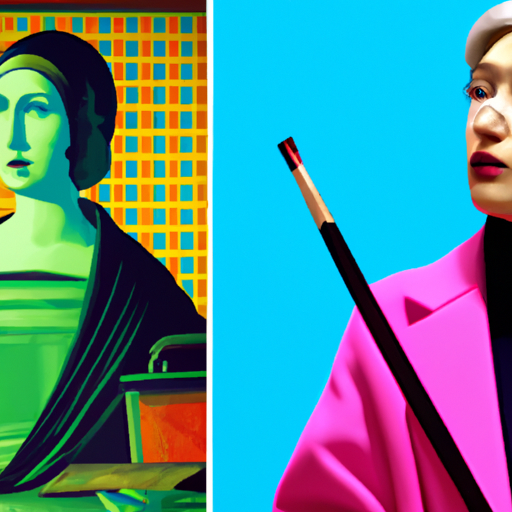-
Table of Contents
Eastern vs. Western Art: Aesthetic Differences for Designers
Art is a universal language that transcends cultural boundaries. However, different regions of the world have distinct artistic traditions and aesthetics that shape the way art is created and perceived. Eastern and Western art, in particular, have long been recognized for their unique styles and approaches. For designers, understanding the aesthetic differences between Eastern and Western art can provide valuable insights and inspiration for their work. In this article, we will explore the key characteristics of Eastern and Western art and discuss how designers can incorporate these aesthetics into their designs.
Eastern Art: Harmony and Symbolism
Eastern art, which includes the artistic traditions of countries like China, Japan, and India, is deeply rooted in spirituality, nature, and symbolism. The key characteristics of Eastern art can be summarized as follows:
- Harmony: Eastern art emphasizes the concept of harmony, both in composition and subject matter. The goal is to create a sense of balance and tranquility that resonates with the viewer.
- Simplicity: Eastern art often embraces simplicity and minimalism. It focuses on capturing the essence of the subject matter rather than intricate details.
- Nature: Nature plays a central role in Eastern art. Artists draw inspiration from the natural world, incorporating elements such as landscapes, flowers, and animals into their work.
- Symbolism: Symbolism is a fundamental aspect of Eastern art. Objects and motifs are often imbued with deeper meanings and convey spiritual or philosophical concepts.
- Calligraphy: Calligraphy is highly regarded in Eastern art, particularly in China and Japan. The brushstrokes and characters themselves are considered artistic expressions.
One example of Eastern art that exemplifies these characteristics is the traditional Japanese ink painting, Sumi-e. Sumi-e paintings are known for their simplicity, use of negative space, and focus on capturing the essence of the subject matter. The paintings often depict natural scenes, such as bamboo, cherry blossoms, or mountains, and convey a sense of tranquility and harmony.
Western Art: Realism and Individual Expression
Western art, which encompasses the artistic traditions of Europe and the Americas, has a rich history that spans centuries. Western art is characterized by the following key elements:
- Realism: Western art has a strong tradition of realism, with artists striving to depict the world as accurately as possible. Attention to detail and perspective are important aspects of Western art.
- Individual Expression: Western art places a significant emphasis on individual expression and the artist’s unique vision. Artists are encouraged to explore their own emotions, ideas, and experiences through their work.
- Human Figure: The human figure has been a central subject in Western art throughout history. Artists have sought to capture the human form in various poses and expressions, often exploring themes of beauty, identity, and the human condition.
- Linear Perspective: Western art has a strong tradition of using linear perspective to create the illusion of depth and space. This technique gives a sense of realism and three-dimensionality to the artwork.
- Oil Painting: Oil painting is a prominent medium in Western art, known for its versatility and ability to create rich textures and colors.
An iconic example of Western art that embodies these characteristics is Leonardo da Vinci’s “Mona Lisa.” The painting is renowned for its realistic portrayal of the human figure, the subtle use of light and shadow, and the enigmatic expression of the subject. “Mona Lisa” is a testament to the individual expression and technical mastery that are highly valued in Western art.
Implications for Designers
Understanding the aesthetic differences between Eastern and Western art can greatly benefit designers. By incorporating elements from both traditions, designers can create visually compelling and culturally sensitive designs. Here are some practical implications for designers:
- Balance and Harmony: Eastern art’s emphasis on balance and harmony can inspire designers to create visually balanced compositions. By carefully considering the placement of elements, designers can achieve a sense of tranquility and unity in their designs.
- Simplicity and Minimalism: Drawing from Eastern art’s simplicity and minimalism, designers can create clean and uncluttered designs that focus on the core message or product. Minimalist design principles can enhance user experience and convey a sense of elegance.
- Nature-Inspired Designs: Incorporating elements from nature, such as organic shapes, natural colors, and textures, can add a sense of serenity and connection to the natural world. This approach is particularly effective in environmental or wellness-related designs.
- Symbolism and Storytelling: Taking cues from Eastern art’s use of symbolism, designers can incorporate meaningful symbols and motifs into their designs. Symbols can convey deeper messages and create a sense of intrigue and storytelling.
- Realism and Individual Expression: Western art’s emphasis on realism and individual expression can inspire designers to create visually striking and emotionally engaging designs. By exploring their own unique perspectives and pushing the boundaries of creativity, designers can create designs that resonate with their audience.
- Exploring Perspectives: Incorporating techniques like linear perspective can add depth and dimension to designs. By experimenting with different perspectives, designers can create visually dynamic and engaging compositions.
Conclusion
Eastern and Western art have distinct aesthetic differences that stem from their respective cultural and historical contexts. Eastern art emphasizes harmony, simplicity, nature, and symbolism, while Western art focuses on realism, individual expression, the human figure, and linear perspective. For designers, understanding these aesthetic differences can provide valuable insights and inspiration for their work. By incorporating elements from both traditions, designers can create visually compelling and culturally sensitive designs that resonate with their audience. Whether it’s finding balance and harmony, embracing simplicity, drawing inspiration from nature, or exploring individual expression, the aesthetics of Eastern and Western art offer a rich tapestry of possibilities for designers to explore and create.
